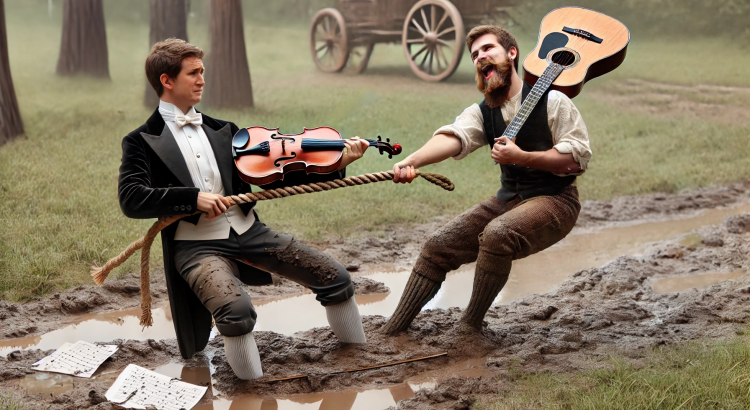It’s easy not to know (or easy to forget) that there are two traditional branches of Western music:
1 – Classical
2 – Folk
And I didn’t invent this: it’s a thing! (See the first paragraph here.)
Note: In this context, “classical” vs. “folk” doesn’t refer to the genres — as in “this sounds like Mozart” vs. “This sounds like Woodie Guthrie.”
It refers to how the music gets made and enjoyed.
Classical, also called art music, is a tradition in which a composer writes down detailed instructions (notation), and others perform that music. (There are superstar exceptions to this, but it’s not the norm.) Because of the attention to detail, Leonard Bernstein suggested renaming it to “specific music.” Classical musicians have a formal education in the language of music (called music theory) — and they devote themselves to structured practice, technique, and knowledge. They even write and analyze a shared language of squiggly symbols (a piece might contain so much information that it’s impractical to memorize anyway). In the classical tradition, everyone knows what they are doing. Because of that, you could call it “educated music.” (Most jazz is an offshoot of this tradition, except what you could call “jazzy songs” — which are, aside from having diatonic 7th chords, standard pop music.) Also, notice that many classical instruments, like violins and oboes, are not easy to play: it’s difficult for a non-player to make even one pleasant sound. And a lot is happening in classical music: long duration, polyphonic layers, dissonance, abstract ideas, and thematic development requiring focus. Most of it is not only hard to make, but it can also be hard to listen to. It’s most often instrumental and in complex forms.
Folk, also called vernacular music, is an older tradition where everyone is welcome. You don’t need to know what you are doing! All (pop)ular genres of music are typically rooted in this tradition: rock, metal, alternative, hip-hop, punk, country, funk, blues, and even what is itself called “folk.” Relative to the classical tradition, it’s easy to get started. You only need basic techniques to write and sing your own songs and jam with your friends. The most common instruments, guitars and drums, make it relatively easy to play listenable sounds. Two chords and a steady beat, and off you go. Even though they could only help, music school and serious study aren’t necessary. That’s why untrained, even illiterate people, or “common folk,” have been at it forever. Music in the folk tradition is meant to be easily created, easily remembered, and easily enjoyed. It’s most often vocal-oriented, homophonic, and in a simple song (verse-chorus-bridge) form.
Further thoughts:
1 – One tradition isn’t objectively better than the other. You have my permission to enjoy them equally!
2 – Genre and tradition aren’t coupled. For example: music can be made in the metal genre but in the classical tradition (“Telepathy Apathy” by Behold… The Arctopus) or folk tradition (“Enter Sandman” by Metallica). Or by blending elements of both traditions, like Mr. Bungle’s Disco Volante. Stravinsky used folk genre melodies in classical tradition music. But that didn’t make it folk tradition. The opposite would also be true: Spinal Tap quoting Boccherini: String Quintet in E Major (classical genre) isn’t classical tradition.
3 – There should be better terms for the two traditions because it’s confusing. Even something like my Type 1 and Type 2 categories could work. In his 2000 book, Music and Memory, Bob Snyder might have coined the terms High-Information Music and Low-Information Music. These could apply to classical and folk traditions, respectively.
4 – Musicologist Philip Tagg says there are not two but THREE traditions: Folk, Art, and Popular.
5 – Jeff Berlin got me thinking about this topic again with his enjoyable rants on Facebook.
It can be helpful to know which tradition(s) you are working in…
If any tradition at all.
-Carl.
